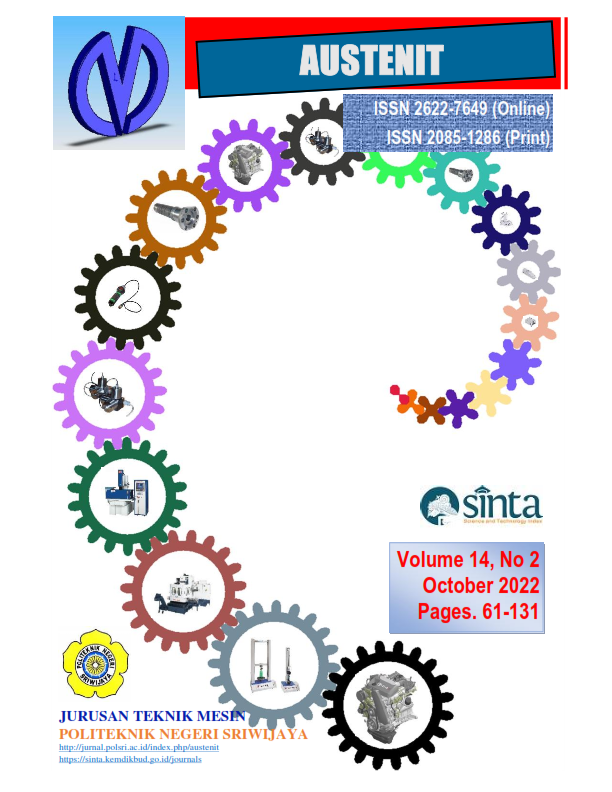PRESSURE SUCTION IMPACT INTO CAR AIR CONDITIONER PERFORMANCE
DOI:
https://doi.org/10.53893/austenit.v14i2.4534Keywords:
Air Conditioning machine, Car, Pressure refrigerant, PerformanceAbstract
A refrigerant is a functioning liquid that flows in the refrigeration cycle which causes a cooling effect on the refrigeration machine. This study aims to determine the impact of refrigerant suction pressure on the performance of car air conditioners. The refrigerant pressure in the refrigeration system can increase and decrease the performance of the A/C system. The test was carried out by varying the 3 refrigerant pressures, 10psi, 20psi, and 30psi on the Car AC trainer testing tool. Based on testing and data processing, the system efficiency performance at 10psi pressure is 81.26%, at 20psi pressure is 81.27% and at 30 psi pressure is 82.13% with actual COP of 6.98, 7.24, 7.36, and Carnot COP of 8.56 respectively. , 8.92, 8.95. Then the impact of changes due to pressure variations in the system on cabin temperature is 22.52℃, 23.01℃, and 23.45℃, respectively. Changes in refrigerant pressure in the car AC engine will affect system performance, where the more significant the suction pressure is given, the efficiency, and the COP value will increase as well as the compressor work and the cabin temperature will increase.
Downloads
References
Budiyanto, E. (2014). Hubungan Tegangan Input Kompresor dan Tekanan Refrigerasi Terhadap COP Mesin Pendingin Ruangan. TURBO ISSN 2301-6663 Vol. 3 N0. 1
https://ojs.ummetro.ac.id/index.php/turbo/article/view/20/19 DOI :10.24127/trb.v3i1.20
Demak, R. K. (2017). Pengaruh Variasi Massa Refrigeran Terhadap Kinerja Air Conditioner Water Heater (ACWH). Demak : Prosiding Snitt Poltekba ISBN: 978-602-51450-0-1
https://jurnal.poltekba.ac.id/index.php/prosiding/article/view/420
Wardika, Sunanto, Sugara Ferry, (2018). Pengaruh Kecepatan Putaran Blower Evaporator Terhadap Kinerja AC Mobil. Jurnal teknologi terapan Polindra vol 4 No.2 e-ISSN 2549-1938 102-105
https://jurnal.polindra.ac.id/index.php/jtt/article/view/138
DOI: https://doi.org/10.31884/jtt.v4i2.138
Dossat, R. J. (1961). Principles of Refrigeration. New York and London: John Wiley and sons, Inc.
Effendy, M. (2009). Optimasi Kapasitas Tekanan Pengisian Refrigeran dan Laju Aliran Udara yang Melintasi Kondensor Terhadap Prestasi Kerja AC Mobil. Surakarta.
https://publikasiilmiah.ums.ac.id/handle/11617/2552
Ivana, I. (2020). Pengaruh Variasi Kecepatan Putaran Fan Kondensor Terhadap Performansi Kinerja Sistem. Indramayu : Politeknik Negeri Indramayu. https://sista.polindra.ac.id/assets/dasboard/assets/data_ta/mahasiswa/481044a29b6a66b24230f51ce5079943.pdf (diakses 16 Juni 2021)
Novarini. (2020). Pengaruh Tekanan Refrigeran R134a Terhadap Nilai Coefficient Of Performance (COP). Jurnal Inovator Vol 4, no 2. http://ojs.politeknikjambi.ac.id/inovator/article/view/136 DOI: https://doi.org/10.37338/ji.v3i2.136
Pramudantoro, T. P. (2017). Pengaruh Variasi Massa Pengisian R290 Sebagai Refrigeran Pengganti R22 Pada Kinerja Freezer. Prosiding Seminar Nasional ReTII ke-12
https://journal.itny.ac.id/index.php/ReTII/article/view/652
Sagoro,D. T. (2017). Analisa Pengaruh Tekanan Kerja ompresor Terhadap Performansi Sistem AC Paa Mobil Daihatsu. Simki-Techsain Vol. 01. Vol. 01 No.10 Tahun 2017.
http://simki.unpkediri.ac.id/detail/13.1.03.01.0044
Selleng, Kristian. Efek Rasio Tekanan Kompresor Terhadap Unjuk Kerja Sistem Refrigerasi R 141b. Mektrik, vol. 9, no. 1, 2007.
http://jurnal.untad.ac.id/jurnal/index.php/Mektek/article/view/414
Umami, N. (2020). Analisa Perubahan Tekanan Pengisian Refrigerant R32 Terhadap Kinerja AC Split 1,5PK Pada Ruangan Dengan Volume 600m3.Tegal : Universitas Pancasakti
http://repository.upstegal.ac.id/id/eprint/2726
Marwan Effendy, (2005). Pengaruh Kecepatan Putar Poros Kompresor Terhadap Prestasi Kerja Mesin Pendingin ACâ€. ISSN 1411-4348, Jurnal Media Mesin Teknik Mesin Universitas Muhammadiyah Surakarta Volume 6 No.2 Juli 2005, halaman hal 55-62.
https://journals.ums.ac.id/index.php/mesin/article/view/2898/0 DOI: 10.23917/mesin.v6i2.2898
Downloads
Published
How to Cite
Issue
Section
License
Copyright (c) 2022 Authors and Publisher

This work is licensed under a Creative Commons Attribution-ShareAlike 4.0 International License.
The Authors submitting a manuscript do so on the understanding that if accepted for publication, Authors retain copyright and grant the AUSTENIT right of first publication with the work simultaneously licensed under a Creative Commons Attribution-ShareAlike License that allows others to share the work with an acknowledgment of the work's authorship and initial publication in this journal.
AUSTENIT, the Editors and the Advisory International Editorial Board make every effort to ensure that no wrong or misleading data, opinions or statements be published in the journal. In any way, the contents of the articles and advertisements published in AUSTENIT are the sole responsibility of their respective authors and advertisers.















